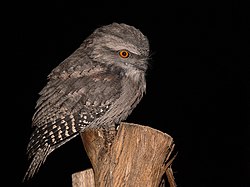| Frogmouths | |
|---|---|
 | |
| Tawny frogmouth, at night | |
| Scientific classification | |
| Kingdom: | Animalia |
| Phylum: | Chordata |
| Class: | Aves |
| Clade: | Strisores |
| Clade: | Vanescaves |
| Order: | Podargiformes Matthews, 1918 |
| Family: | Podargidae Gray, 1847 |
| Genera | |

The frogmouths (Podargidae) are a group of nocturnal birds related to owlet-nightjars, swifts, and hummingbirds. Species in the group are distributed in the Indomalayan and Australasian realms.








